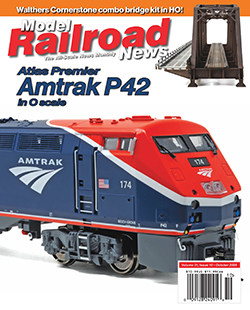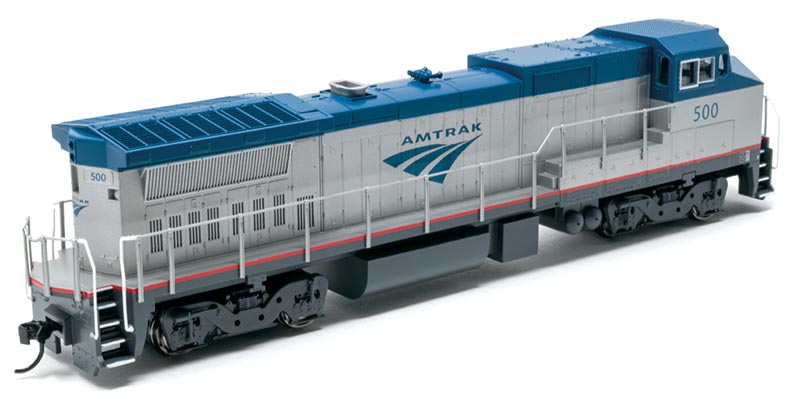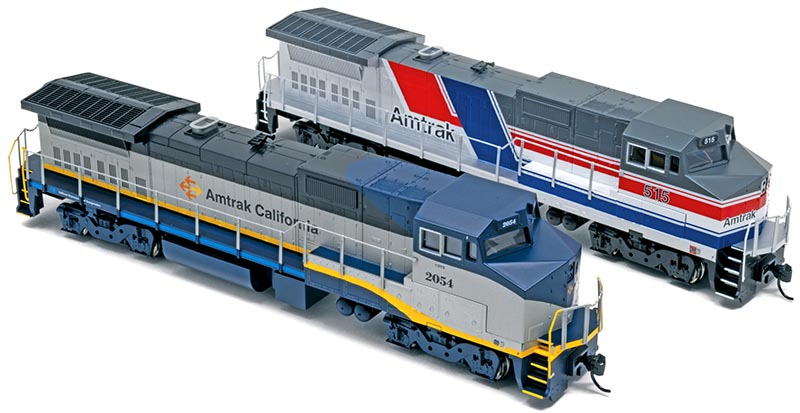 Review by Aaron Adams/photos by Tony Cook
Review by Aaron Adams/photos by Tony Cook
After several years of absence, Walthers Mainline General Electric (GE) Dash 8 diesel locomotive model returns with both new and previously offered paint schemes. Editor Tony Cook covered two freight versions (wide-nose BNSF Dash 8-40BW and regular cab Santa Fe Dash 8-40B) in our June 2025 issue. Walthers also offers a passenger model based on Amtrak’s unique Dash 8-32BWH variation.
By the early 1990s Amtrak’s fleet of EMD F40PH’s was beginning to age, with the oldest locomotives dating back to 1975, so the passenger carrier was in search of new diesel motive power to supplement its fleet. General Electric provided a solution by adapting the four-axle, wide-cab model of its Dash 8 series freight locomotive, the Dash 8-40BW, which it was building for Santa Fe at the time. Changes to make it suitable for passenger service included a smaller fuel tank, reduced horsepower (3,200 hp compared to the 4,000 hp of its freight counterparts), and the ability to provide head-end power, abbreviated as HEP, for electricity in passenger cars. This variation would be designated as the Dash 8-32BWH, with “32” signifying the reduced horsepower and “H” for the HEP capability. Amtrak took delivery of 20 examples in 1991, with two paid for by the California Department of Transportation. GE would go on to make up the majority of Amtrak’s diesel fleet, mostly in the form of P40DC and P42DC Genesis-series locomotives, until the recent switch to new Siemens Charger locomotives. In the last decade, Amtrak has primarily used its Dash 8 fleet for secondary service such as yard switching and maintenance trains, while the larger Genesis fleet served as the primary diesel power for most of Amtrak’s routes.
Walthers has included four different Amtrak paint schemes in this run, with four numbers each: Phase III (AMTK 515 shown at left), Phase IV (not covered here) and Phase V (AMTK 500), and Amtrak California (AMTK 2054). The most unique paint scheme has to be the as-delivered Phase III scheme, which earned these locomotives the nickname “Pepsi Can,” because of their bright red, white, and blue colors.

After a few years, the two units paid for by California were renumbered from AMTK 501 and 502 to CDTX 2051 and 2052 and permanently assigned to the state-funded Amtrak California routes. In order to match Amtrak California’s bi-level passenger car fleet, they were repainted silver, dark blue, and yellow. Amtrak’s simpler blue and silver Phase V scheme, seen on our sample of Amtrak 500, was introduced in the early 2000s and is the paint job currently worn by the Dash 8 fleet other than California’s two units.
All three paint schemes covered here are nicely rendered and match the colors from Amtrak’s paint scheme and logo guide. The Amtrak California model matches the version of that paint scheme used from 2004 and 2008, which has a V-shaped section of dark blue paint on the nose and CDTX reporting marks below the cab windows.
Because Amtrak California only rosters two Dash 8s, 2051 and 2052, Walthers created two more numbers, 2053 and 2054, to allow for four road numbers matching what is available on the other schemes offered. While the entry-level target for these budget-friendly engines may not notice or find fault with this, it is a little disappointing because Mainline locomotives are usually prototypically accurate even if they include fewer details…



